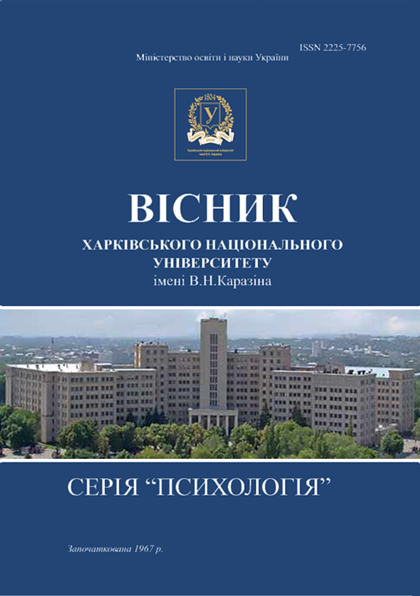INTERRELATION OF BEHAVIOR SELF-REGULATION STYLE AND TYPES OF INNOVATIVE THINKING IN STUDENTS
Abstract
The article discusses the relationship between the style of behavior self- regulation and the type of
innovative thinking among students. The study used the questionnaire «The Style of Behavior Self- Regulation Behavior» by V. I. Morosanova and О. M. Konoz and the KAIMA test, which is a modification of the M. Kirton test to determine the type of innovative thinking, which was developed by M. V. Prokhorova and A. D. Teregulova. The sample consisted of 96 students of the V. N. Karazin Kharkiv National University. The first group consisted of 32 students, who, according to the results of testing, were assigned to adapters. The second group consisted of 28 students, who were assigned to innovators. A further study excluded 9 subjects who demonstrated results that allowed them to be identified as “super adaptors” and “super innovators”, as well as 27 subjects who showed average scores, which indicates the ambivalence of the manifestations of the adaptive-innovative style of thinking. It is established that adapters with increasing capacity for innovative thinking increase the need for conscious planning of activities, and such components of individual style selfregulation as modeling, evaluation of results and flexibility become less pronounced. Innovators have only one significant relationship between innovative thinking and regulatory flexibility, which, unlike adapters, is positive. The obtained results testify to the differences in the functioning of individual style self-regulation in the context of innovative thinking in adapters and innovators. A certain specificity of the interrelationship between innovation of thinking and individual-style self-regulation of adapters and innovators proves that these two types are complementary to each other in the process of regulation of activity and behavior in terms of their psychological characteristics. It is noted that the results of this study confirm the need for an individual approach to each student. So, both “innovators” and “adapters” can be equally effective due to application of inherent in each type of special techniques and approaches to solving problems.
Downloads
References
Быкова Е. А. Психологические механизмы формирования готовности обучающихся к инновационной деятельности. Известия Саратовского университета. Новая серия. Серия Акмеология образования. Психология развития. 2017. Т. 6. №. 4. С. 294 – 299.
Вітвицька С.С. Особистісно орієнтоване виховання студентів у вищих навчальних закладах освіти. Професійна педагогічна освіта: особистісно орієнтований підхід : монографія / за ред. О.А. Дубасенюк. Житомир : Вид-во ЖДУ ім. І. Франка, 2012. С. 50-78.
Галян І. Психологічний аналіз сутності саморегуляції як особистісної. Збірник наукових праць:
психологія (Збірник наукових праць: філософія, соціологія, психологія). 2015. С. 154-161.
Гринців М. Психічна саморегуляція як умова особистісного зростання студентів. Проблеми гуманітарних наук. Психологія. 2015. №. 37. С. 67–79.
Джагарян В.Е., Синченко Т.Ю. Специфика стилей мішления и стилей саморегуляции у аспирантов гуманитароного и технического профилей. Инновационный потенциал субъектов образовательного пространства в условиях модернизации образования: материалы Первой Международной научно-практической конференции (24–26 нояб ря 2010 г., Ростов-на-Дону). Ростов н/Д: ИПО ПИ ЮФУ, 2010. С. 634 – 639.
Кузнєцова О. В. Факторна структура простору адаптивно-інновативних характеристик особистості. Наука і освіта. 2015. №. 11-12. С. 66-73.
Лисенко-Гелембʼюк К. Вплив саморегуляції на соціалізацію особистості: історя та сучасний погляд на проблему. Освітній простір України. 2014. №. 4. – С. 26-33.
Милославська О. В. До проблеми розвитку творчого мислення в студентів. Вісник Харківського національного університету імені ВН Каразіна. Серія: Психологія. 2015. №. 57. С. 49-52.
Моросанова В.И., Коноз Е.М. Стилевая саморегуляция поведения человека. Вопросы психологии. 2000. №2. С. 118-127.
Пахно И. В. Инновационная активность и новообразования личности: метасистемный подход.
Психология в экономике и управлении. 2015. Т. 7. – №. 1. С. 16-25.
Прохорова М. В., Терегулова А. Д. Диагностика адапторско-инноваторского когнитивного стиля. Вестник Нижегородского университета им. Н.И. Лобачевского. 2014. №. 2-1. С. 400-406.
Психологический словарь / Под общ. ред. А.В. Петровского, М.Г. Ярошевского. 2-е изд., испр.
и доп. М.: Политиздат. - 492с.
Усольцев А. П., Шамало Т. Н. Понятие инновационного мышления. Педагогическое образование в России. 2014. №. 1. С. 94-98.




